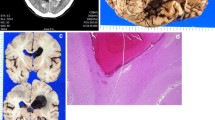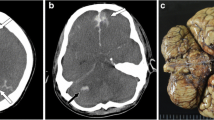Abstract
The purpose of this study was to assess the incidence of fatal hemorrhage complicated with methamphetamine (MA) poisoning and to examine the postmortem computed tomography (PMCT) features of fatal intracerebral hemorrhage (ICH) with and without MA poisoning. The study also attempted to determine the differences in PMCT between those two groups. Consecutive medicolegal autopsy data from November 2011 to February 2018 were searched for 3044 cases. First, the incidence and distribution of all cases of nontraumatic fatal hemorrhage with various causes were examined. Second, cases of ICH on the basal ganglia and brain stem were extracted. The PMCT findings were compared with respect to nine parameters: volume of hematoma, ventricular perforation, midline shift distance, aortic calcification, calcification of aortic valve, calcification of coronary artery, cardiothoracic ratio, circumference of ascending aorta, and volume of bladder contents. Of the 3044 cases, 97 were nontraumatic fatal hemorrhage; of these 97 cases, 20 were classified as MA poisoning with 9 ICH cases, and 60 cases were classified as non-MA poisoning with 14 ICH cases. A statistically significant difference in ages was observed between the two groups. On PMCT comparison of ICH, statistically significant differences were evident in the midline shift distance and calcification of the aortic valve. Forensic radiologists should be aware of the possibility of ICH with MA poisoning if fatal hemorrhage is detected on PMCT. Younger age, less calcification of the aortic valve, and a remarkable midline shift may be the keys to recognition.



Similar content being viewed by others
References
United Nations Office on Drugs and Crime. World drug report 2016. New York: United Nations; 2016. https://www.unodc.org/wdr2018/
Degenhardt L, Whiteford HA, Ferrari AJ, Baxter AJ, Charlson FJ, Hall WD, et al. Global burden of disease attributable to illicit drug use and dependence: findings from the global burden of disease study 2010. Lancet. 2013;382:1564–74.
Darke S, Kaye S, McKetin R, Duflou J. Major physical and psychological harms of methamphetamine use. Drug Alcohol Rev. 2008;27:253–62.
Callaghan C, Cunningham JK, Verdichevski M, et al. All-cause mortality among individuals with disorders related to the use of methamphetamine: a comparative cohort study. Drug Alcohol Depend. 2012;125:290–4.
O’Donnell C, Woodford N. Post-mortem radiology - a new-subspecialty? Clin Radiol. 2008;63:1189–94.
Thali MJ, Yen K, Schweitzer W, Vock P, Boesch C, Ozdoba C, et al. Virtopsy, a new imaging horizon in forensic pathology: virtual autopsy by postmortem multi-slice computed tomography (MSCT) and magnetic resonance imaging (MRI) - a feasibility study. J Forensic Sci. 2003;48:386–403.
Takahashi N, Higuchi T, Shiotani M, Satou S, Hirose Y. Effectiveness of a worksheet for diagnosing postmortem computed tomography in emergency departments. Jpn J Radiol. 2011;29:701–6.
McGee SM, McGee DN, McGee MB. Spontaneous intracerebral hemorrhage related to methamphetamine abuse: autopsy findings and clinical correlation. Am J Forensic Med Pathol. 2004;25:334–7.
Lappin JM, Darke S, Farrell M. Stroke and methamphetamine use in young adults: a review. J Neurol Neurosurg Psychiatry. 2017;88:1079–91.
Westover AN, McBride S, Haley RW. Stroke in young adults who abuse amphetamines or cocaine: a population-based study of hospitalized patients. Arch Gen Psychiatry. 2007;64:495–502.
McEvoy AW, Kitchen ND, Thomas DG. Intracerebral hemorrhage and drug abuse in young adults. Br J Neurosurg. 2000;14:449–54.
de los Ríos F, Kleindorfer DO, Khoury J, Broderick JP, Moomaw CJ, Adeoye O, et al. Trends in substance abuse preceding stroke among young adults: a population-based study. Stroke. 2012;43:3179–83.
Ho EL, Josephson SA, Lee HS, Smith WS. Cerebrovascular complications of methamphetamine abuse. Neurocrit Care. 2009;10:295–305.
Beadell NC, Thompson EM, Delashaw JB, Cetas JS. The deleterious effects of methamphetamine use on initial presentation and clinical outcomes in aneurysmal subarachnoid hemorrhage. J Neurosurg. 2012;117:781–6.
Huang MC, Yang SY, Lin SK, Chen KY, Chen YY, Kuo CJ, et al. Risk of cardiovascular diseases and stroke events in methamphetamine users: a 10-year follow-up study. J Clin Psychiatry. 2016;77:1396–403.
Darke S, Lappin J, Kaye S, Duflou J. Clinical characteristics of fatal methamphetamine –related stroke: a National Study. J Forensic Sci. 2018;63:735–9.
Schulz M, Iwersen-Bergmann S, Andresen H, Schmoldt A. Therapeutic and toxic blood concentrations of nearly 1000 drugs and other xenobiotics. Crit Care. 2012;16:R136.
Tormoehlen LM, Blatsioris AD, Moser EA, Carter RJ, Stevenson A, Ofner S, et al. Disparities and guideline adherence in drugs of abuse screening in intracerebral hemorrhage. Neurology. 2017;88:252–8.
Bentur Y, Bloom-Krasik A, Raikhlin-Eisenkraft B. Illicit cathinone (“Hagigat”) poisoning. Clin Toxicol. 2008;46:206–10.
Rose DZ, Guerrero WR, Mokin MV, Gooch CL, Bozeman AC, Pearson JM, et al. Hemorrhagic stroke following use of the synthetic marijuana ‘spice’. Neurology. 2015;85:1177–9.
Gee P, Tallon C, Long N, Moore G, Boet R, Jackson S. Use of recreational drug 1,3 dimethylamylamine (DMAA) associated with cerebral hemorrhage. Ann Emerg Med. 2012;60:431–4.
Kaye S, McKetin R, Duflou J, Darke S. Methamphetamine and cardiovascular pathology: a review of the evidence. Addiction. 2007;102:1204–11.
Rye KA, Barter PJ, Brown AJ. Speed kills in more ways than one: methamphetamine and atherosclerosis. Atherosclerosis. 2015;243:654–5.
The annual report of National Police Agency in Japan, 2018. https://www.npa.go.jp.
Acknowledgments
We thank Hisako Saitoh, Yukiko Oya, Keisuke Okaba, Katsura Otsuka, Yuriko Oodo, Miyuki Miura, and Kazuhiro Kobayashi for their technical support.
Author information
Authors and Affiliations
Corresponding author
Additional information
Publisher’s note
Springer Nature remains neutral with regard to jurisdictional claims in published maps and institutional affiliations.
Electronic supplementary material
ESM 1
A man aged in his 50s was found dead at home wearing only underwear. Criminal record of methamphetamine (MA) abuse (+). Circumstantial evidence included a used syringe (+). The blood concentration of MA was 3.4 μg/mL. (a) and (b) Superficially, an injection scar and fresh injection site were detected (arrows). (c) On postmortem computed tomography, massive hemorrhage was detected on the pons. (d) At autopsy, massive hemorrhage on the pons was confirmed. (PNG 719 kb)
ESM 2
A female aged in her 50s was found dead at home. Criminal record of methamphetamine (MA) abuse (−). Circumstantial evidence included a used syringe (−). The blood concentration of MA was 0.45 μg/mL. (a) Superficially, an injection scar and fresh injection site were not detected. (b) On postmortem computed tomography, subarachnoid hemorrhage (SAH), mainly located on the basal cistern, was detected. (c) At autopsy, SAH caused by aneurysm rupture of the left vertebral artery was confirmed. (d) Enlarged image of the rupture site of the left vertebral artery (arrow). (PNG 768 kb)
Rights and permissions
About this article
Cite this article
Yoshida, M., Makino, Y., Hoshioka, Y. et al. Fatal hemorrhage complicated with methamphetamine poisoning and its post-mortem CT features. Forensic Sci Med Pathol 16, 577–585 (2020). https://doi.org/10.1007/s12024-020-00294-5
Accepted:
Published:
Issue Date:
DOI: https://doi.org/10.1007/s12024-020-00294-5




